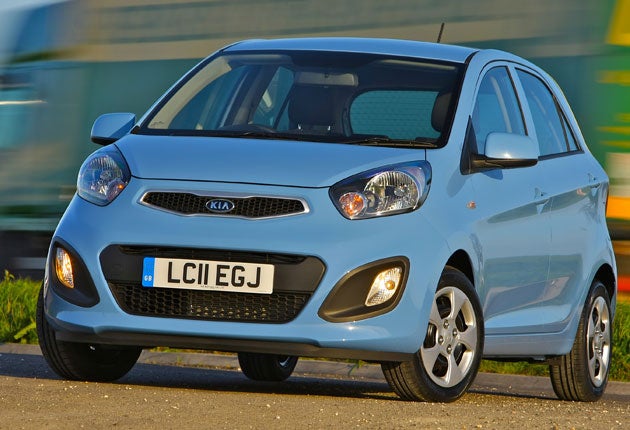Kia Picanto 1 Air
As most cars seem to get bigger, it's good to welcome a small, but perfectly formed, newcomer

This road test features the new Kia Picanto. And before we go any further, I shall set out some definitions.
Pay heed, because the entire automotive canon is about to be reclassified. Grade inflation has been as rife in motor cars as it has been in school exam results, and we need to return to the truth.
A Ford Fiesta, a Vauxhall Corsa, a Volkswagen Polo, a Renault Clio, a Citroën C3: none of these, in current form, is a "supermini". They are compact family cars, as big as a Golf or a Focus used to be. Today's Golf, Focus and Astra are practically as big as a Mondeo once was, while a new Mondeo or a Vauxhall Insignia are truly large cars. Why all these cars have grown is a mystery, but it's a lamentable trend, especially if we're trying to save energy. Cars need to be smaller and lighter, no excuses.
So we must stop calling a Fiesta a supermini, and reserve the term for genuinely compact, cleverly-designed cars able to carry four people but take up minimal road-room. The true superminis are Fiat's 500 and Panda, Hyundai's i10, the Aygo/C1/107 triplets. And one of the most popular of the breed has been the Kia Picanto, launched in 2004 as a cheap piece of functional minimalism but later upstaged by its more sophisticated, but still great value, Hyundai i10 cousin.
So now the Picanto has been recast in the i10 mould but with Kia's racier, wedgier take on the styling. Inevitably the new Picanto has expanded slightly over the old one, but it's just two inches or so longer than before and most derivatives still weigh comfortably under a tonne.
The wheelbase has also grown a bit, now matching that of the i10 whose underpinnings it shares. The Picanto also shares the new "Kappa" engine range recently launched in the revised i10, modern units low on CO2 output and high on responsiveness. Previously there was the undiverse choice of 1.0 or 1.1 litres, but now the gap is widened with 1.0 and 1.25 litre options.
Both engines are particularly quiet and smooth, and it's this attribute, along with a similarly quiet and smooth ride over bumps, that makes the new Picanto feel a much higher-quality machine than the old one. The new interior helps here, too, with its more sophisticated dashboard design and instruments no longer graduated in strident orange, but all the plastic surfaces are still hard as you would expect in a car of this price.
Ah yes, price. At £7,995 the entry-level version costs a hefty £2,000 more than 2007's entry Picanto did, but all cars are significantly more expensive now than then and the price does include an unusually generous seven-year warranty. Another £500 adds air-conditioning, which many buyers now regard as a near-essential feature, while grander Picanto 2 and 3 models add more gadgets and plushness in the usual fashion. The 1.25-litre engine can be had with a four-speed manual transmission.
There's a lot of room inside the Picanto, enough for five people at a pinch. The boot is bigger than before, too, having grown from token gesture to viable suitcase repository.
Driving this correctly-sized supermini, I wonder if we really need any more car than this. It's true that the three-cylinder engine struggles to overtake at speed, but it's such a game little engine in the urban setting, with its deep exhaust note and keen accelerator response, that you can easily forgive its ultimate lack of muscularity.
The 1.25-litre engine has 84bhp, which makes for a significantly peppier Picanto (0-60mph in 11 seconds against 13.9). It can also be had with a stop-start system which brings its CO2 down to an impressive 100g/km. All new Picantos, however, have accurate and nicely-weighted steering and friendly, tidy handling. They feel fluent and relaxed on the road, a pleasure to drive, and make the notion of a larger, mainstream supermini appear pointless. Who needs a Fiesta/Clio/ Polo now?
The Rivals
Fiat 500 TwinAir: from £10,865, 85bhp, 95g/km
Expensive in this company but terrific two-cylinder engine is punchy to drive. Four-cylinder 1.2 version costs £800 less.
Hyundai i10 1.0 Blue: £9,195, 68bhp, 99g/km
Good little car in its own right, but arrival of mechanically-identical Picanto makes i10's higher price hard to justify. Five-year warranty here.
Suzuki Alto: from £8,345, 68bhp, 103g/km
Another good-value three-cylinder, but very basic compared with Kia. Similar idea to Aygo/107/C1 but rather more fun to drive.
Join our commenting forum
Join thought-provoking conversations, follow other Independent readers and see their replies
Comments